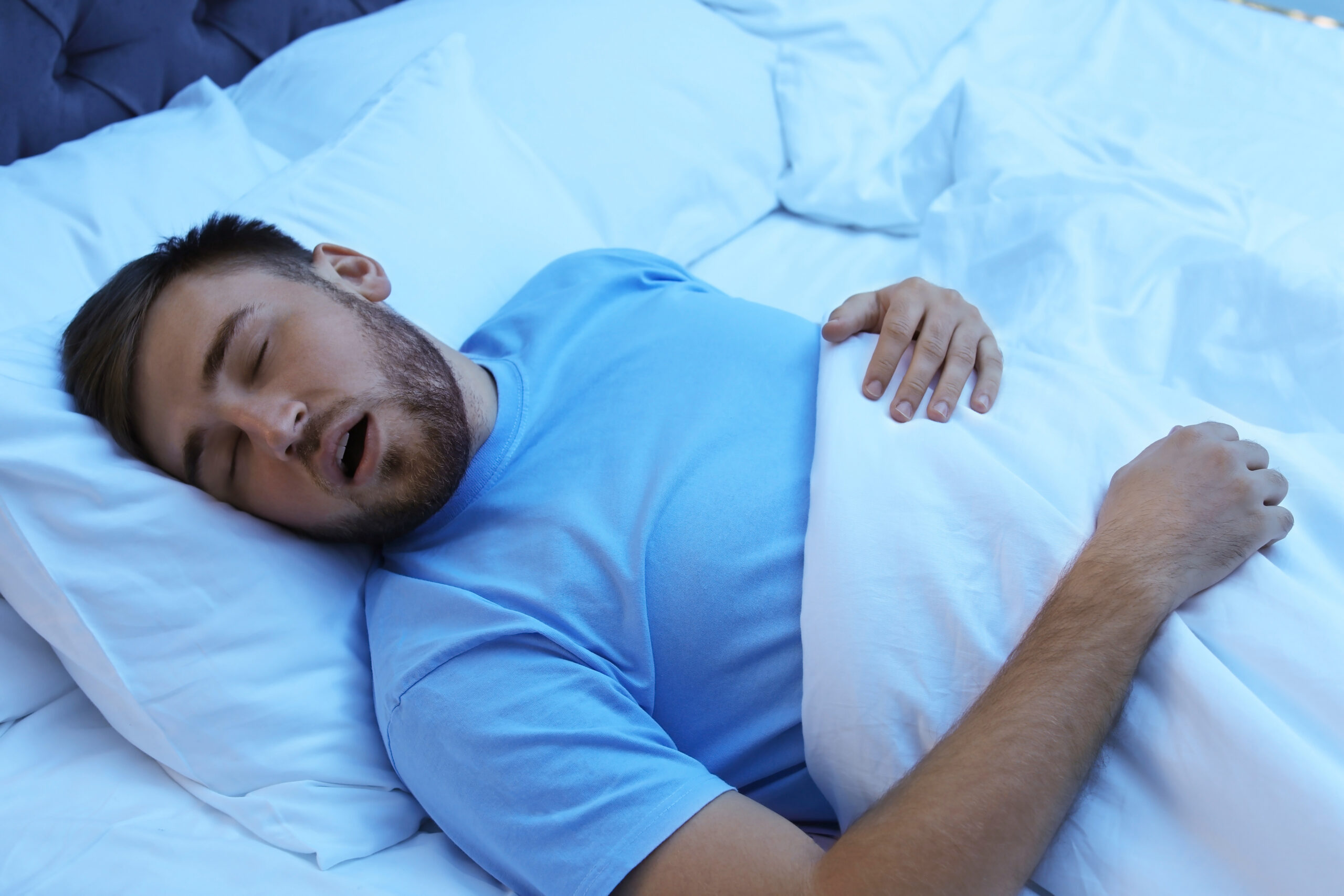

Sleep is essential for our health, allowing our bodies to rest and rejuvenate. But what happens when your sleep is constantly interrupted by a condition known as sleep apnea? Sleep apnea involves repeated episodes of shallow or paused breathing during sleep, disrupting your rest and leading to a myriad of health problems. But sleep apnea is not merely an inconvenient sleep disorder. It can have serious implications for your health if left untreated, including cardiovascular disease, metabolic diseases, and cognitive issues. Awareness of the signs and symptoms is the first step towards diagnosis and treatment.
Sleep Apnea Symptoms
Sleep apnea is a serious condition that occurs when breathing repeatedly stops and starts during the night. Two hallmark sleep apnea symptoms are snoring and daytime fatigue, but they aren’t the only symptoms that can occur. Headaches can also be common, as well as unexplained high blood pressure, metabolic disturbances, or hormone imbalance.
Snoring
One of the most significant sleep apnea symptoms is snoring, specifically if it’s loud and persistent. The snoring associated with sleep apnea is due to the partial blockage of your airway while you sleep, or obstructive sleep apnea. This blockage causes the tissues in the back of your throat to vibrate as you struggle to breathe, which in turn creates the sound of snoring. The key difference between normal snoring and sleep apnea is the presence of a distinctive snorting, choking or gasping sound. This sound is a sign that your breathing has been momentarily interrupted or even stopped completely. Another type of sleep apnea that is not associated with snoring is called central sleep apnea, in which the signal from the brain is not getting through enough to keep you breathing regularly.
Daytime Fatigue
Another common sleep apnea symptom is excessive daytime sleepiness, also known as hypersomnia. This happens because sleep apnea disrupts your natural sleep cycle, preventing you from getting a full, restful night’s sleep. Daytime fatigue can be dangerous and disruptive, affecting your performance at work or school and increasing your risk of accidents, including car accidents. You may also experience difficulty concentrating, forgetfulness, and decreased productivity, all of which can be attributed to poor sleep quality.
Other sleep apnea signs and symptoms can include:
- Brain fog
- Mood disturbances like anxiety, depression, or irritability
- Poor concentration and memory
- Headaches
- Hormone Changes
- High blood pressure
- Heart rhythm changes
- Blood sugar dysregulation
Are There Risks to Not Treating Sleep Apnea?
If not treated, sleep apnea can lead to a host of health problems, both immediate and long-term. It can increase the risk of high blood pressure, heart attack, stroke, obesity, hormone dysfunction, and diabetes. It can also make arrhythmias, or irregular heartbeats, more likely. Sleep apnea affects your sleep quality, leading to fatigue during the day, which can impair your ability to function normally and reduce your quality of life.
Because of the potential risks of not pursuing treatment, getting professional help for sleep apnea symptoms is important.
Different Types of Sleep Apnea
There are two main types of sleep apnea:
- Obstructive sleep apnea: This is the more common form that occurs when throat muscles relax.
- Central sleep apnea: In this form of sleep apnea, the brain doesn’t send proper signals to the muscles that control breathing.
Sleep Apnea Tests: How to Test for Sleep Apnea
Sleep apnea testing is essential for proper diagnosis and treatment planning. There are two main tests for sleep apnea: a home sleep study test and an in-office sleep study test.
Home Sleep Tests
A home sleep test is an easy and convenient way to identify sleep apnea. It involves using a device that you take home with you from the doctor’s office. This device will measure variables like your heart rate, blood oxygen level using pulse oximetry, respiratory effort, body position and movement, breathing patterns, and level of snoring while you sleep. Although home sleep tests can be very useful, they are not as comprehensive as an in-office sleep study.
In-Office Sleep Study
An in-office sleep study, also known as a polysomnogram, is a more detailed way to evaluate sleep disorders. During this test, you will be asked to sleep overnight in a medical office with a trained sleep technician present throughout the study. Electrodes are attached to your head and body to monitor your brain waves (EEG), sleep stages, eye movements, heart rate, heart rhythm, and blood pressure. The test will also check your airflow, oxygen levels, and breathing efforts. This method provides the most comprehensive data and is considered the gold standard for diagnosing sleep apnea.
Sleep apnea is a serious condition that requires prompt attention. A home sleep test and an in-office sleep study are two effective sleep apnea tests. If you suspect you have sleep apnea, consult your healthcare provider to determine the best testing method for you. Remember, the key to successful treatment is early detection.
Sleep Apnea Treatment
Fortunately, sleep apnea can be effectively managed with appropriate treatment. Lifestyle changes like losing weight, quitting smoking, and avoiding alcohol can help reduce sleep apnea symptoms. Various types of oral devices can help keep the airway open during sleep. More severe cases of sleep apnea may require therapies such as continuous positive airway pressure (CPAP) or other types of positive airway pressure machines. In some cases, surgery might be helpful if there are tonsil/adenoid, sinus or other airway issues present as the root causes of sleep apnea.
CPAP
The most common sleep apnea treatment for moderate to severe cases is Continuous Positive Airway Pressure (CPAP). This involves a machine that delivers air pressure through a mask placed over your nose while you sleep. The pressure is somewhat greater than that of the surrounding air and is just enough to keep your upper airway passages open, preventing apnea and snoring. Studies show that the use of CPAP, especially in overweight individuals, improves insulin sensitivity and reduces blood pressure more than any other sleep apnea treatment.
BiPAP
BiPAP (Bilevel Positive Airway Pressure) is similar to the CPAP device but offers varying levels of air pressure. These can be more comfortable for some patients and are usually recommended when CPAP treatment is not tolerated, or more help is needed to improve the delivery of the positive pressure that helps with the airway obstruction. This device automatically adjusts the pressure while you’re sleeping, providing more pressure when you inhale and less when you exhale. This can make breathing and sleep more comfortable for some people.
Dental Devices
For individuals with mild sleep apnea, oral appliances like an oral mandibular advancement device may be a good sleep apnea treatment option. These mandibular repositioning devices are designed to keep the throat open by bringing your jaw forward, which can sometimes relieve snoring and mild obstructive sleep apnea. Studies show that these devices are most effective in mild sleep apnea cases. A dentist experienced in treating sleep apnea can fit you with such a device.
While less effective than CPAP, oral appliances are easier to use and carry on trips, making them a preferred choice for some patients. They are comfortable, portable, and silent, which makes them an excellent alternative.
Hypoglossal Nerve Stimulation
Hypoglossal nerve stimulation (HNS) works by stimulating the hypoglossal nerve, which controls the movement of the tongue. An implantable device is surgically placed under the skin in the chest area. This device is connected to the hypoglossal nerve and delivers mild stimulation to keep the airway open during sleep. Unlike CPAP, HNS is a permanent solution that doesn’t require the use of any external equipment during sleep.
Surgery
In certain cases, surgery may be recommended to correct any anatomical contributors. Surgeons may remove large tonsils or adenoids, recommend sinus surgery, or remove extra tissue from the rear of the throat (uvula), called a uvulopalatopharyngoplasty or UPPP. These surgeries are designed to enlarge the airway and facilitate breathing during sleep but are often only considered when other treatments are ineffective, or there is an obvious anatomical obstruction that can be helped with these procedures. It is important to be able to breathe through your nose, as mouth breathing is associated with increased risk for a handful of chronic conditions.
Weight Loss and Lifestyle Changes
In some cases, lifestyle changes might be all that you need. Losing weight, quitting smoking, and avoiding alcohol can significantly improve sleep apnea symptoms. Regular physical activity and a healthy diet can also make a huge difference.
Lifestyle changes should not be seen as a quick fix, but rather as a long-term strategy. They generally work best when used in conjunction with other treatments to achieve the best results, especially in more severe cases of sleep apnea. Everyone is different, so it might take some time to figure out what lifestyle changes work best for you.
Sleep Apnea Treatment and Arizona Wellness Medicine
Sleep apnea is a severe health condition that can lead to an array of health complications if left untreated. Being aware of the risks associated with sleep apnea is the first step towards seeking appropriate treatment. If you or a loved one snores loudly or shows signs of being excessively tired despite ample sleep, it may be time to consult a healthcare professional. Early diagnosis and proper sleep apnea treatment can help mitigate the risks and lead to better health and an improved quality of life. We do offer accurate at home sleep apnea testing as the initial screening, with results as soon as the next day. We also work with local sleep experts to find the right treatment plan personalized for you!
At Arizona Wellness Medicine, we’re trained in all the latest sleep apnea treatments and lifestyle changes. Our team is dedicated to supporting you, whether that’s through diet change, getting to the root of your symptoms, or making an individualized treatment plan. We’re here to help! Learn more about how functional medicine can help you here.
Resources:
Share:
Dr. Emily Parke
Social Media
Most Popular Posts
Subscribe To Our Newsletter
Related Posts

How Fructose Intake Affects Metabolic Health: What You Need to Know
Fructose, found naturally in fruits and added to processed foods as high fructose corn syrup, impacts health. Learn the metabolic effects of fructose intake.

Get More Vitamin D for Better Health!
Of all the vitamins and minerals you should be sure you’re getting enough of, vitamin D is perhaps one of the most important. The benefits of vitamin D are widespread and pretty incredible.

The Science Behind Protein: The Optimal Amount of Protein in the Diet Based on Age and Activity Level
Different amounts of protein are needed at different stages of life. Learn about protein, how much you need, and what happens when you don’t get enough.

Magnesium: The Essential Mineral, Its Role in the Body, and What to Know About Magnesium Supplements
Learn about the mineral magnesium, its role in the body, how to spot magnesium deficiency, and the most bioavailable forms of magnesium to supplement with.
